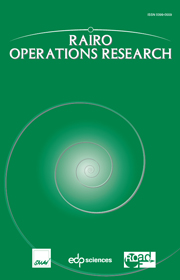Article contents
Solving the Crop Allocation Problemusing Hard and Soft Constraints∗
Published online by Cambridge University Press: 18 April 2013
Abstract
Application tools for the crop allocation problem (CAP) are required for agricultural advisors to design more efficient farming systems. Despite the extensive treatment of this issue by agronomists in the past, few methods tackle the crop allocation problem considering both the spatial and the temporal aspects of the CAP. In this paper, we precisely propose an original formulation addressing the crop allocation planning problem while taking farmers’ management choices into account. These choices are naturally represented by hard and soft constraints in the Weighted CSP formalism. We illustrate our proposition by solving a medium–size virtual farm using either a WCSP solver (toulbar2) or an ILP solver (NumberJack/SCIP). This preliminary work foreshadows the development of a decision–aid tool for supporting farmers in their crop allocation strategies.
- Type
- Research Article
- Information
- RAIRO - Operations Research , Volume 47 , Issue 2: ConstraintProgramming , April 2013 , pp. 151 - 172
- Copyright
- © EDP Sciences, ROADEF, SMAI, 2013
References
- 9
- Cited by


